14 min read
Electric underfloor heating VS wet underfloor heating, what's right for you?
There's something special about walking across a warm floor in the middle of winter, knowing your next door neighbour is freezing their toes off...
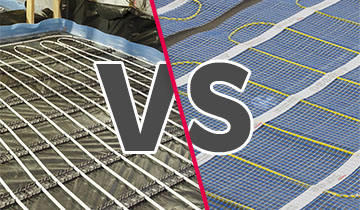
In this heating blog article, we will be walking you through both water underfloor heating and electric underfloor heating to help you decide what type of underfloor heating system is best for your next project.
We’ll be covering:
ThermoSphere is a specialist (and manufacturer) when it comes to electric underfloor heating, so if you have any questions of the electric variety, contact us. If you are looking for more detailed technical support for water underfloor heating, reach out to our friends at WMS, who will be happy to help.
Think of underfloor heating as a system that turns your floor into a giant radiator. The radiant heat rises upwards and is evenly distributed through the room, which means no cold spots in the room and no family feuds being caused by battling over who has the comfy seat nearest the radiator.
Water underfloor heating
Water underfloor heating (hydronic or wet) is made up of a series of pipes which are installed under the floor finish and uses warm water to generate the heat. A manifold is connected between the pipework and the heat source (usually a boiler or heat pump), which makes sure that the water is at the right temperature and flow rate to heat up the floor.
There are a wide range of water underfloor heating system to choose from depending on the type of project. For example, the popular screeded floor systems to suspended floor systems that are more suited for battened or joisted floors.
If you have a boiler or heat pump installed (or are planning to install one), we recommend talking to them to ensure that it is suitable for water underfloor heating.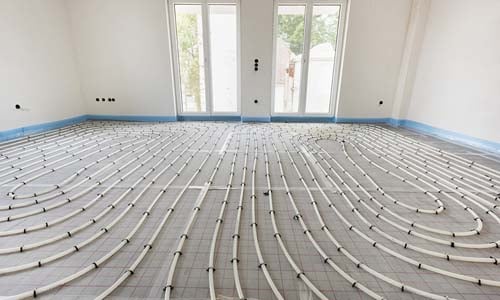
Electric underfloor heating
Electric underfloor heating is installed underneath the floor finish such as tiles, vinyl and even carpet. It is connected to the mains electricity supply (by a qualified electrician) and controlled with a thermostat. Remember, not all thermostats work with underfloor heating. When switched on, the heating cable heats up warming the surface of the floor generating radiant heat. You can buy the heating cable as an in-screed cable system, a heating and decoupling system (perfect for tiled floors), pre-spaced as a mat which you simply roll out or a foil system that is ideal for floating floors.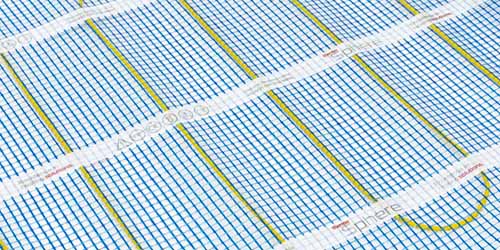
Water underfloor heating
You’ll see water underfloor heating systems more frequently within new build projects and larger room areas, especially if they are being used as a primary source of heating for the space. This is because it is much easier to accommodate a water underfloor heating system in the design stage of the project especially if there are restrictions to floor height. With renovation projects there may not be sufficient floor height to accommodate the wet underfloor heating pipework without major disruption.
When installed within a typical 65mm – 75mm sand and cement screed, a water underfloor heating system can take up to two hours to warm up to the desired temperature. The heat is stored for longer due to the mass of screed that is heated up. There are many types of screeds that can be used too. Thinner flow screeds conduct heat to the floor finish better and because of this, heat up times become more in line with electric systems, which are around 30 to 40 minutes.
Cons: Longer time to heat up, sometimes requires upgrades to the boiler and new pipework which can be disruptive to the project.
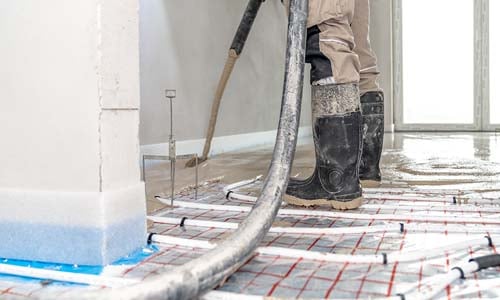
Electric underfloor heating
Electric underfloor heating is more commonly used in renovations or for smaller floor areas. This is because there is little impact on floor height and it has a faster installation time (depending on the size of the room). However, it’s not solely used in renovation projects, it’s rising in popularity for new build projects too. This is due to several factors including:
On average, it takes 20-30 minutes for an electric underfloor heating system to heat the room to the desired temperature as long as the system has been installed correctly and with insulation boards.
Electric underfloor heating systems come in a range of outputs. For example, 100W/m2, 150W/m2 and 200W/m2. The higher the wattage the faster the heat up time. So, for bathroom projects we would recommend an output of 150Wm2 and for high heat loss spaces such as conservatories, we would recommend 200W/m2.
Cons: Uses electrical load that might be difficult to wire in, requires programming to be an efficient system (only on when you need it on).
Checkatrade have some great examples of how much you will be looking to pay to have underfloor heating installed.
The average quote is £800 to install 10m2 of electric underfloor heating and for water underfloor heating it’s £1,200. The cost of installing differs again based on if it is a new build or a renovation project.
Material costs for water underfloor heating vary but as an example, you can purchase a ProWarm™ Standard Output Water Underfloor Heating Kit for a 12m2 area for just under £700 (including a thermostat).
For electric underfloor heating, the average market price for a 12m2 ThermoSphere Mesh 150W/m2 system (including a thermostat), will cost under £600).
The running cost of your underfloor heating system will be influenced by a multitude of factors which include:
Without taking into consideration regional variance of tariffs or the Energy Price Guarantee, the cost of electricity per kilowatt hour (52p) is much more that of gas (15p). This means water underfloor heating systems are cheaper to run when used with a traditional gas boiler. It’s also one of the reasons why water underfloor heating is used for much larger floor areas as it would cost less to run compared to electric underfloor heating. You can reduce the flow temperature further and save even more on the running cost.
If your electric underfloor heating system is, as an example (and for easier maths), 200W per square metre, it will cost you 52p for every 5 metres of floor when you have the system on.
When using electric underfloor heating, you’ll find that it is only on for between 2 and 4 hours per day and more commonly found in much smaller areas than a water underfloor heating system. On average, we have found that to run a 3m2 electric underfloor heating for four hours per day will cost in the region of £0.70 to £1.00 depending on the output of the system you have installed and other factors mentioned above.
Wet underfloor heating systems do not need maintenance directly. However, if you don’t already, ensure you have an annual boiler check because if that ends up breaking, you won’t be able to enjoy the comfort that a wet underfloor heating system provides. Another annual check to be mindful of is checking the system manifold for leaks. Within the manifold itself there are washers and sometimes valves which can wear overtime, so it is worth a professional checking these periodically.
Electric underfloor heating doesn’t have any essential maintenance costs because there are no moving parts. However, it is important that you ensure that the system is tested at three stages during the installation process to get your lifetime warranty as well as peace of mind that the system hasn’t been accidently damaged during installation.
Read ‘How to test an electric underfloor heating system’ for further details.
Both electric and wet underfloor heating systems are both extremely energy efficient. In fact, both are much more efficient at heating a room when comparing to a traditional central heating system. You’ll find that a water underfloor heating is typically 25% more efficient than traditional central heating and works at a much lower temperature which means it is cheaper to run.
The real difference between both underfloor heating systems is how the heat is transported. With a wet underfloor heating system, a boiler would be typically used to heat the water, then it is transported through a network of pipes to heat the room. Between 20% - 40% of the energy is lost as a result.
An electric underfloor heating system is 100% efficient at point of use. How? There’s no need to transport the heat as each joule of energy is converted exactly where the heat is needed. That means that every pound spent on running it is converted to heat.
It really comes down to what the project is, how large the heated area needs to be, floor build ups and more. New builds where large spaces are going to be heated probably favour wet underfloor heating but everything else is perfect for electric, especially retrofit projects. Be mindful of running costs of each system and the costs to maintain them to keep them at their peak performance.
For further detail on electric underfloor heating such as running costs, installation top tips and answers to the most common questions, explore ThermoSphere’s heating blog.
Alternatively, please contact one of the ThermoSphere team who will be happy to help.
Complete the short form and you'll receive a fast quote turnaround time along with the right product details for your property or project.
Need it even quicker? Call our HQ and one of the team will be happy to help on 0800 019 5899.
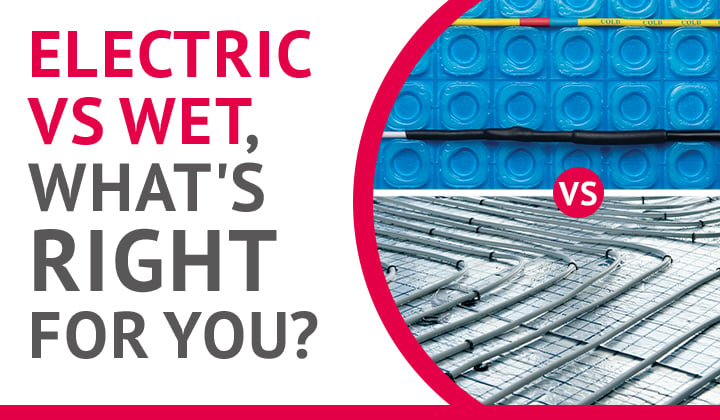
14 min read
There's something special about walking across a warm floor in the middle of winter, knowing your next door neighbour is freezing their toes off...

9 min read
It’s great that you are thinking about installing underfloor heating for your next project. You’ll receive all the benefits that come with underfloor...
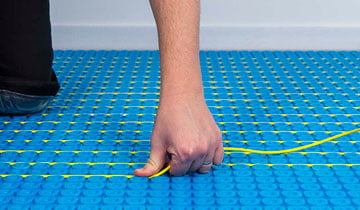
8 min read
If you are in the market for an electric underfloor heating system for your next home renovation, then you have landed in the perfect place. We’ve...